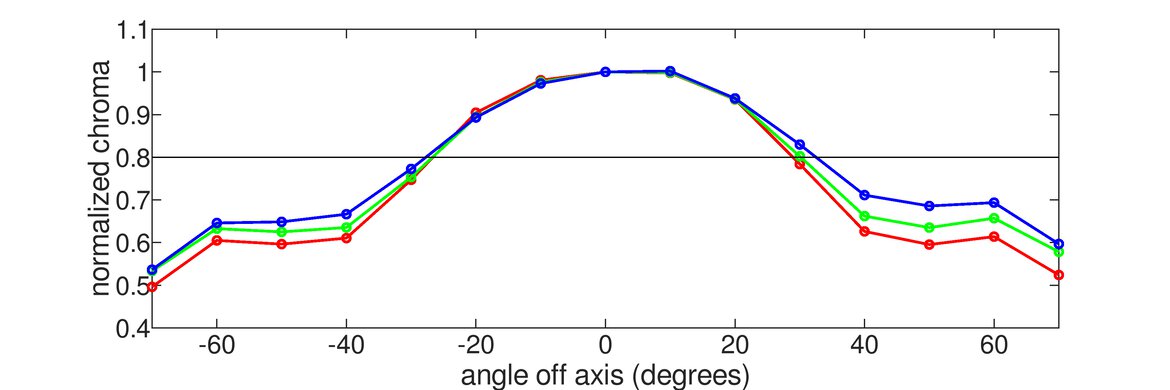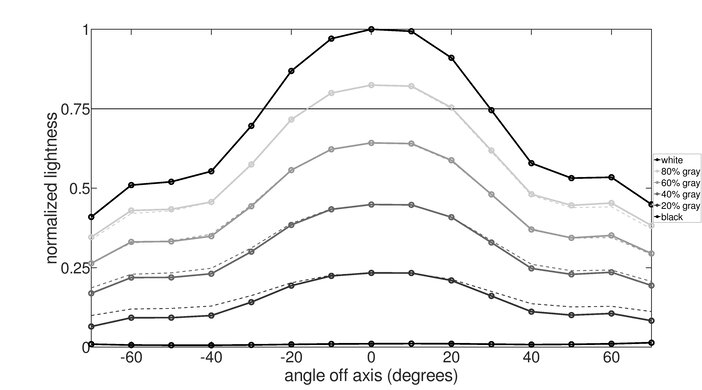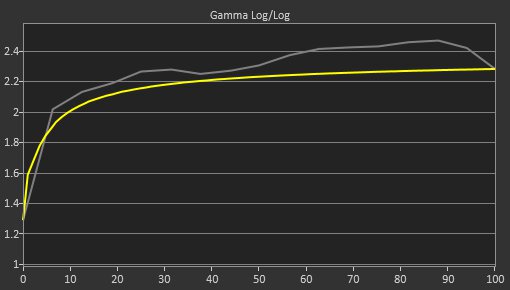The Dell C1422H is a 14 inch portable monitor with a 1080p screen designed for productivity, and it's the first portable monitor released by Dell. Visibility isn't an issue in brighter environments, thanks to its decent peak brightness and good reflection handling. It has limited connectivity, with two USB-C ports that both support DisplayPort Alt Mode but no DisplayPort or Mini HDMI inputs, so you'll need to buy an adapter if your computer doesn't support USB-C. It also doesn't have a built-in battery, but it can be powered by your computer if it supports USB-C Power Delivery; otherwise, you'll need to buy a wall adapter for it, which is a bit disappointing. Unfortunately, it has almost no extra features, and it's mediocre for gaming, with a slow response time and no support for advanced gaming features like variable refresh rate technology.
Our Verdict
The Dell C1422H is an alright portable monitor. It's best-suited for mobile office use, increasing your productivity when working on a laptop, as it has excellent text clarity, good visibility in bright rooms, and excellent gray uniformity. It's also alright for media creators or for watching videos. Sadly, it's not as good for gaming, as it has a slow response time, terrible overshoot, and it doesn't support any advanced gaming features like FreeSync.
- High pixel density results in crisp images and text.
- Image remains accurate at moderate angles.
- Good reflection handling.
- Slow response times makes motion look blurry.
- Blacks look gray in a dark room.
- Bad ergonomics, as expected for a portable monitor.
- Small screen size isn't ideal for some uses.
The Dell C1422H is a decent portable office monitor. It has excellent text clarity, and good visibility in a bright room, with decent peak brightness and good reflection handling. It has excellent gray uniformity, the image remains accurate at an angle, and it has good gradient handling. It's also good for color-accurate work, as it has good accuracy out of the box and an excellent SDR color gamut. Unfortunately, it has terrible ergonomics, as expected for a portable monitor, and it's small for multitasking.
- High pixel density results in crisp images and text.
- Image remains accurate at moderate angles.
- Good reflection handling.
- Good accuracy out of the box.
- Excellent SDR color gamut.
- Bad ergonomics, as expected for a portable monitor.
- Small screen size isn't ideal for some uses.
The Dell 14 Portable Monitor C1422H is mediocre for gaming. It has superb low input lag for a responsive gaming experience, and it has good bright room visibility, with decent peak brightness and good reflection handling and it can easily overcome glare. Sadly, it has a low refresh rate, a slow response time, and terrible overshoot, resulting in very blurry motion. It also lacks any advanced gaming features like FreeSync or G-SYNC to reduce tearing.
- High pixel density results in crisp images and text.
- Low input lag.
- No VRR support.
- Slow response times makes motion look blurry.
- Blacks look gray in a dark room.
- Bad ergonomics, as expected for a portable monitor.
The Dell 14 Portable Monitor C1422H is okay for watching videos on the go. The small size is great for portability, but it's hard to share the screen with someone else, and it isn't very immersive. It has good visibility in bright rooms, though, with decent peak brightness and good reflection handling. It also has excellent gray uniformity, good accuracy out of the box, and an excellent color gamut. Sadly, it doesn't look as good in a dark room, as it has low contrast and only passable black uniformity.
- High pixel density results in crisp images and text.
- Image remains accurate at moderate angles.
- Good reflection handling.
- Good accuracy out of the box.
- Excellent SDR color gamut.
- Blacks look gray in a dark room.
- No HDR support.
- Bad ergonomics, as expected for a portable monitor.
The Dell 14 Portable Monitor C1422H is okay for media creation. The image remains accurate at an angle, and it has excellent gray uniformity and good accuracy out of the box. It has an excellent SDR color gamut, but it has limited coverage of the Adobe RGB color space. Unfortunately, as expected for a portable monitor, it has terrible ergonomics, and the small size isn't ideal for full-time work, but it's okay for quick edits on the go.
- High pixel density results in crisp images and text.
- Good reflection handling.
- Good accuracy out of the box.
- Excellent SDR color gamut.
- Bad ergonomics, as expected for a portable monitor.
- Small screen size isn't ideal for some uses.
The Dell 14 Portable Monitor C1422H doesn't support HDR.
Check Price
Differences Between Sizes And Variants
We tested the 14 inch Dell C1422H, which is only available in this 14 inch size. It's also Dell's first portable monitor. If you notice that your C1422H is different from ours, let us know, and we'll update the review. Keep in mind that some tests, like gray uniformity, can vary between units.
Our unit was manufactured in August 2021, and you can see the label here.
Popular Monitor Comparisons
The Dell C1422H is an okay portable monitor. It's Dell's first portable display, and it performs nearly identically to the Lenovo ThinkVision M14. It suffers from the same shortcomings as most portable displays, but it's not a bad choice overall, and it's better than most portable monitors we've tested to date, but it's also more expensive.
See our recommendations for the best portable monitors, the best office monitors, and the best monitors for a dual setup.
The Lenovo ThinkVision M14 and the Dell C1422H are nearly identical, and we suspect they share the same panel. The differences between them are mainly due to panel variance. The Lenovo can be mounted on a 100x100 VESA mount, but other than that, these two displays are basically the same.
The ASUS ROG Strix XG16AHPE is much better than the Dell C1422H. The ASUS has a much faster refresh rate, significantly better motion handling, and better gaming features, including support for variable refresh rate technology. The ASUS also has a larger screen, built-in speakers, and an HDMI port, as well as two USB-C ports.
The Lepow Z1 Gamut and the Dell C1422H have different strengths and weaknesses, so the best one depends on your needs. The Lepow has a much better color gamut, and it supports HDR. On the other hand, the Dell is a lot brighter, and it's more accurate out of the box, so it's a better choice for a bright environment or if accuracy is important to you.
The ASUS TUF Gaming VG258QM and the Dell C1422H are two very different monitors with different intended uses. The ASUS is a medium-sized desktop monitor designed for gaming, with an extremely fast refresh rate and support for Adaptive Sync variable refresh rate technology. The Dell, on the other hand, is a compact portable monitor designed for improved productivity on the go.

We buy and test more than 30 monitors each year, with units that we buy completely on our own, without any cherry-picked units or samples. We put a lot into each unbiased, straight-to-the-point review, and there's a whole process from purchasing to publishing, involving multiple teams and people. We do more than just use the monitor for a week; we use specialized and custom tools to measure various aspects with objective data-based results. We also consider multiple factors before making any recommendations, including the monitor's cost, its performance against the competition, and whether or not it's easy to find.
Test Results

The Dell C1422H has a stylish, modern design. It looks a lot like the Lenovo ThinkVision M14. Designed with portability in mind, it has very thin bezels on three sides and a built-in kickstand that also houses the monitor's inputs.
The back of the monitor is smooth and plain, with a simple Dell logo etched into the back. It looks a lot like some of Dell's XPS laptops. As expected for a portable monitor, there's no cable management.
As expected for a monitor with an IPS panel, the Dell C1422H has mediocre contrast, and blacks look gray in a dark room. These results are much higher than the typical contrast ratio of 700:1 advertised by Dell, but this can vary between individual units. We expect that our unit is better than most units.
This monitor doesn't support local dimming. We still film the video so you can see how the backlight performs versus other monitors.
The Dell 14 Portable Monitor C1422H has decent peak brightness in SDR. It's bright enough to overcome glare in most indoor settings, but it's not bright enough for use outdoors. There's very little variation in brightness with different scenes, but small windows are dimmed by the display. This isn't really noticeable with real content.
Note: We measured the peak brightness after calibration, with the brightness set to max. This monitor has no picture settings, meaning these are also the brightest results possible for it.
This monitor doesn't support HDR.
The Dell C1422H has an okay horizontal viewing angle, but it's slightly worse than most monitors with IPS panels. Although black levels remain accurate at a wide angle, colors washout and shift at a moderate angle. These results are nearly identical to the Lenovo ThinkVision M14, which appears to use the same panel.
This monitor has a decent vertical viewing angle. Again, black levels remain accurate at a wide angle, but colors look washed out at a moderate angle. There's less color shift, though, and gamma remains accurate to a slightly wider angle.
The Dell 14 Portable Monitor C1422H has excellent gray uniformity. The sides of the screen are darker than the center, but there's almost no dirty screen effect. Near-dark scenes look much better, with no noticeable issues. This can vary between individual units, but gray uniformity is rarely an issue on recent monitors.
The Dell 14 Portable Monitor C1422H has passable black uniformity. The entire screen is cloudy due to the low contrast ratio, and there's some noticeable backlight bleed, especially along the bottom bezel of our unit. Note that the black uniformity can vary between individual units.
The Dell C1422H that we bought has good accuracy out of the box, but this can vary between individual units. Colors have great accuracy, with few noticeable issues, but the white balance is off, especially in brighter shades of gray. Gamma doesn't follow the sRGB target curve, though, and most scenes are darker than they should be. The color temperature is very cool, giving everything a bluish tint.
After calibration, the Dell 14 Portable Monitor C1422H has fantastic accuracy. There are no noticeable issues in the white balance or color accuracy, and gamma is very close to the sRGB curve. The color temperature is nearly perfect. Unfortunately, this monitor doesn't have any picture settings, and the only way to achieve this level of accuracy is through calibration.
You can download our ICC profile calibration here. This is provided for reference only and shouldn't be used, as the calibration values vary per individual unit due to manufacturing tolerances, even for the same model.
The Dell 14 Portable Monitor C1422H has an excellent SDR color gamut. It has nearly perfect coverage of the sRGB gamut used by most current desktop and web content, including games. Sadly, it can't display colors wider than the sRGB primaries in the Adobe RGB color space, disappointing for professional content creators.
This monitor has amazing color volume in SDR. It fills out the sRGB color volume well, and colors are bright and vibrant. Due to the low contrast ratio, it can't display saturated colors at low luminance levels.
This monitor doesn't support HDR.
This monitor doesn't support HDR.
Unfortunately, there are some signs of temporary image retention on our Dell 14 Portable Monitor C1422H. They disappear quickly, though, and it's not really noticeable with real content. Note that this can vary between individual units.
The Dell 14 Portable Monitor C1422H has good reflection handling. It has a matte anti-reflective coating that significantly reduces the intensity of direct reflections but also spreads them out on the screen.
| Overdrive Setting | Response Time Chart | Response Time Tables | Motion Blur Photo |
| None | Chart | Table | Photo |
Unfortunately, the Dell C1422H has a bad response time. There's significant blur behind fast-moving objects, which is especially noticeable when gaming. There's also terrible overshoot, causing a long trail of inverse ghosting, and unlike most monitors, there are no overdrive settings.
Unfortunately, this monitor doesn't have an optional backlight strobing feature, commonly known as black frame insertion, to improve the appearance of motion.
The Dell 14 Portable Monitor C1422H is limited to a 60Hz refresh rate, and it doesn't support any advanced gaming features like FreeSync or G-SYNC.
The Dell 14 Portable Monitor C1422H has superb low input lag, resulting in a very responsive desktop and gaming experience.
The relatively small size of this monitor is great for portability but only okay for regular work and multitasking.
The Dell 14 Portable Monitor C1422H has two USB-C ports, both of which support DisplayPort Alt Mode and up to 65W of power delivery when connected to a powerful enough adapter (at least 90W, not included). It can also be powered by the source directly if it supports power delivery.
This is a very bare-bones monitor with almost no additional features. The biggest additional feature advertised by Dell is their ComfortView mode, which reduces the amount of blue light the backlight emits. Most modern operating systems can do this already with any display.
The controls are very basic. There's a rocker switch that adjusts the backlight and a toggle for the ComfortView feature. There's also a physical power button on the other side.














































